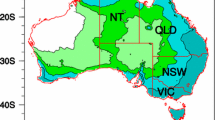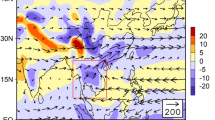Abstract
The interdecadal modulation of the relationship between El Niño–Southern Oscillation (ENSO) and the South China spring rainfall (SCSR) by the Pacific Decadal Oscillation (PDO) is investigated using long-term observational datasets. When ENSO and PDO are in-phase [i.e., El Niño events during warm PDO (EN_WPDO) and La Niña events during cold PDO (LN_CPDO)], the positive correlations between ENSO and SCSR are enhanced significantly, with above-normal (below-normal) SCSR generally following EN_WPDO (LN_CPDO) events. In contrast, the ENSO–SCSR relationship becomes ambiguous when ENSO and PDO are out-of-phase [i.e., El Niño events during cold PDO (EN_CPDO) and La Niña events during warm PDO (LN_WPDO)]. The PDO modulates the ENSO–SCSR relationship through the impact of variations in the lower-tropospheric subtropical anticyclone over the western North Pacific (WNP) and upper-tropospheric westerly jets over East Asia and the midlatitude North Pacific. An EN_WPDO (LN_CPDO) event induces an enhanced subtropical anticyclone (cyclone) over the WNP and intensified (weakened) subtropical westerly jet around the southern Tibetan Plateau due to modification by the PDO-forced anomalous circulation. Thus, South China falls just under the influence of the anomalous lower-tropospheric southwesterlies (northeasterlies) and upper-tropospheric divergent (convergent) environment, leading to above-normal (below-normal) SCSR. In contrast, the SCSR anomalies exhibit no wet or dry preference following EN_CPDO (LN_CPDO) events, because ENSO-induced and PDO-forced circulation anomalies tend to cancel each other out. These modulating effects by the PDO on the ENSO–SCSR relationship and related physical processes are also examined with coupled model simulations.












Similar content being viewed by others

References
Ashok K, Behera SK, Rao SA, Weng HY, Yamagata T (2007) El Niño Modoki and its possible teleconnection. J Geophys Res 112:C11007. doi:10.1029/2006jc003798
Chan JCL, Zhou W (2005) PDO, ENSO and the early summer monsoon rainfall over South China. Geophys Res Lett 32:L08810. doi:10.1029/2004gl022015
Chen J, Wen Z, Wu R, Chen Z, Zhao P (2013a) Interdecadal changes in the relationship between southern China winter–spring precipitation and ENSO. Clim Dyn 43:1327–1338
Chen W, Feng J, Wu RG (2013b) Roles of ENSO in the link of the East Asian winter monsoon to the following summer monsoon. J Clim 26:622–635
Compo GP et al (2011) The twentieth century reanalysis project. Q J R Meteorol Soc 137:1–28
DeFlorio MJ, Pierce DW, Cayan DR, Miller AJ (2013) Western U.S. extreme precipitation events and their relation to ENSO and PDO in CCSM4. J Clim 26:4231–4243
Deng LP, Wang QQ (2002) On the relationship between precipitation anomalies in the first raining season (April–June) in southern China and SST over offshore waters in China. J Trop Meteorol 18:45–55 (in Chinese)
Ding YH (2004) Seasonal March of the East-Asian summer monsoon. In: Chang CP (ed) East Asian Monsoon. Mainland Press, Singapore, pp 3–53
Ding RQ, Ha K-J, Li JP (2010) Interdecadal shift in the relationship between the East Asian summer monsoon and the tropical Indian Ocean. Clim Dyn 34:1059–1071
Efron B (1982) The jackknife, the bootstrap and other resampling plans. Capital City Press, Montpelier, pp 27–36
Feng J, Li JP (2011) Influence of El Niño Modoki on spring rainfall over South China. J Geophys Res 116:D13102. doi:10.1029/2010jd015160
Feng J, Wang L, Chen W (2014) How does the East Asian Summer Monsoon behave in the decaying phase of El Niño during different PDO phases? J Clim 27:2682–2698
Gao H, Wang YG, He JH (2006) Weakening significance of ENSO as a predictor of summer precipitation in China. Geophys Res Lett 33:L09807. doi:10.1029/2005gl025511
Gershunov A, Barnett TP (1998) Interdecadal modulation of ENSO teleconnections. Bull Am Meteorol Soc 79:2715–2725
Gong DY, Wang SW (1998) Impact of ENSO on the seasonal rainfall in China. J Nat Disasters 7:44–52 (in Chinese)
Ha K-J, Heo K-Y, Lee S-S, Yun K-S, Jhun J-G (2012) Variability in the East Asian Monsoon: a review. Meteorol Appl 19:200–215
Harris I, Jones PD, Osborn TJ, Lister DH (2014) Updated high-resolution grids of monthly climatic observations-the CRU TS3.10 Dataset. Int J Climatol 34:623–642
Huang RH, Wu YF (1989) The influence of ENSO on the summer climate change in China and its mechanism. Adv Atmos Sci 6:21–32
Karori MA, Li JP, Jin FF (2013) The asymmetric influence of the two types of El Niño and La Niña on Summer Rainfall over Southeast China. J Clim 26:4567–4582
Kim JW, Yeh SW, Chang EC (2014) Combined effect of El Niño-Southern Oscillation and Pacific Decadal Oscillation on the East Asian winter monsoon. Clim Dyn 42:957–971
Krishnamurthy L, Krishnamurthy V (2014) Influence of PDO on South Asian summer monsoon and monsoon-ENSO relation. Clim Dyn 42:2397–2410
Lau KM, Li MT (1984) The Monsoon of East-Asia and its global associations—a survey. Bull Am Meteorol Soc 65:114–125
Lee S-S, Vinayachandran PN, Ha K-J, Jhun J-G (2010) Shift of peak in summer monsoon rainfall over Korea and its association with ENSO. J Geophys Res 115:D02111. doi:10.1029/2009JD011717
Lee S-S, Seo Y-W, Ha K-J, Jhun J-G (2013) Impact of the western North Pacific subtropical high on the East Asian Monsoon precipitation and the Indian Ocean precipitation in the boreal summertime. Asia-Pac J Atmos Sci 49:171–182
Li J, Yu RC, Yuan WH, Chen HM, Sun W, Zhang Y (2015) Precipitation over East Asia simulated by NCAR CAM5 at different horizontal resolutions. J Adv Model Earth Syst 7:774–790
Linho LH, Huang XL, Lau NC (2008) Winter-to-spring transition in East Asia: a planetary-scale perspective of the South China spring rain onset. J Clim 21:3081–3096
Mantua NJ, Hare SR, Zhang Y, Wallace JM, Francis RC (1997) A Pacific interdecadal climate oscillation with impacts on salmon production. Bull Am Meteorol Soc 78:1069–1079
Mao JY, Chan JCL, Wu GX (2004) Relationship between the onset of the South China Sea summer monsoon and the structure of the Asian subtropical anticyclone. J Meteorol Soc Jpn 82:845–859
Mao JY, Chan JCL, Wu GX (2011) Interannual variations of early summer monsoon rainfall over South China under different PDO backgrounds. Int J Climatol 31:847–862
Namias J, Yuan XJ, Cayan DR (1988) Persistence of North Pacific Sea surface temperature and atmospheric flow patterns. J Clim 1:682–703
Pan WJ, Mao JY, Wu GX (2013) Characteristics and mechanism of the 10–20-day oscillation of spring rainfall over southern China. J Clim 26:5072–5087
Qiang XM, Yang XQ (2013) Relationship between the first rainy season precipitation anomaly in South China and the sea surface temperature anomaly in the Pacific. Chin J Geophys 56:2583–2598 (in Chinese)
Rayner NA et al (2003) Global analyses of sea surface temperature, sea ice, and night marine air temperature since the late nineteenth century. J Geophys Res 108(D14):4407. doi:10.1029/2002JD002670
Shao TH, Zhang YC (2012) Influence of winter North Atlantic Oscillation on spring precipitation in China. Plateau Meteorol 31:1225–1233 (in Chinese)
Sperber K et al (2013) The Asian summer monsoon: an intercomparison of CMIP5 vs. CMIP3 simulations of the late 20th century. Clim Dyn 41:2711–2744
Stickler A et al (2014) ERA-CLIM historical surface and upper-air data for future reanalyses. Bull Am Meteorol Soc 95:1419–1430
Tao SY, Chen LX (1987) A review of recent research on the East Asian summer monsoon in China. In: Chang CP, Krishnamurti TN (eds) Monsoon meteorology. Oxford University Press, London, pp 60–92
Tao SY, Zhang QY (1998) Response of the Asian winter and summer monsoon to ENSO events. Sci Atmos Sin 22:399–407 (in Chinese)
Taylor KE, Stouffer RJ, Meehl FA (2012) An overview of CMIP5 and the experiment design. Bull Am Meteorol Soc 93:485–498
Uccellini LW, Kocin PJ (1987) The interaction of jet streak circulations during heavy snow events along the east coast of the United States. Weather Forecast 2:289–308
Wan RJ, Wu GX (2009) Temporal and spatial distributions of the spring persistent rains over Southeastern China. Acta Meteorol Sin 23:598–608
Wang B, Wu RG, Fu XH (2000) Pacific-East Asian teleconnection: how does ENSO affect East Asian climate? J Clim 13:1517–1536
Wang B, Yang J, Zhou TJ (2008) Interdecadal changes in the major modes of Asian-Australian monsoon variability: strengthening relationship with ENSO since the late 1970s. J Clim 21:1771–1789
Wang SS, Huang JP, He YL, Guan YP (2014) Combined effects of the Pacific Decadal Oscillation and El Niño–Southern Oscillation on global land dry–wet changes. Sci Rep 4:6651. doi:10.1038/Srep06651
Watanabe M, Jin FF (2003) A moist linear baroclinic model: coupled dynamical-convective response to El Niño. J Clim 16:1121–1139
Webster PJ, Hoyos C (2004) Prediction of monsoon rainfall and river discharge on 15–30-day time scales. Bull Am Meteorol Soc 85:1746–1765
Wu RG, Kirtman BP (2007) Observed relationship of spring and summer East Asian rainfall with winter and spring Eurasian snow. J Clim 20:1285–1304
Wu RG, Hu ZZ, Kirtman BP (2003) Evolution of ENSO-related rainfall anomalies in East Asia. J Clim 16:3742–3758
Yang FL, Lau KM (2004) Trend and variability of China precipitation in spring and summer: linkage to sea-surface temperatures. Int J Climatol 24:1625–1644
Yang JL, Liu QY, Xie SP, Liu ZY, Wu LX (2007) Impact of the Indian Ocean SST basin mode on the Asian summer monsoon. Geophys Res Lett 34:L02708. doi:10.1029/2006gl028571
Yoon J, Yeh SW (2010) Influence of the Pacific Decadal Oscillation on the relationship between El Niño and the Northeast Asian Summer Monsoon. J Clim 23:4525–4537
Yu B, Zwiers FW (2007) The impact of combined ENSO and PDO on the PNA climate: a 1,000-year climate modeling study. Clim Dyn 29:837–851
Yun K-S, Seo K-H, Ha K-J (2010) Interdecadal change in the relationship between ENSO and the intraseasonal oscillation in East Asia. J Clim 23:3599–3612
Zheng F, Li JP (2012) Impact of preceding boreal winter southern hemisphere annular mode on spring precipitation over South China and related mechanism. Chin J Geophys 55:3542–3557 (in Chinese)
Zheng F, Li JP, Wang L, Xie F, Li XF (2015) Cross-seasonal influence of the December–February southern hemisphere annular mode on March–May meridional circulation and precipitation. J Clim. doi:10.1175/jcli-d-14-00515.1
Zhou LT, Wu RG (2010) Respective impacts of the East Asian winter monsoon and ENSO on winter rainfall in China. J Geophys Res 115:D02107. doi:10.1029/2009jd012502
Zhou LT, Tam CY, Zhou W, Chan JCL (2010) Influence of South China Sea SST and the ENSO on winter rainfall over South China. Adv Atmos Sci 27:832–844
Zhu YM, Yang XQ (2003) Relationships between Pacific Decadal Oscillation (PDO) and climate variabilities in China. Acta Meteorol Sin 61:641–654 (in Chinese)
Acknowledgments
The authors thank the two anonymous reviewers for their constructive suggestions. This research was jointly supported by the National Basic Research Program of China (2014CB953902, 2012CB955202, and 2012CB417203), the Priority Research Program of the Chinese Academy of Sciences (XDA11010402), and the Natural Science Foundation of China (41175059, 41375087, and 91537103).
Author information
Authors and Affiliations
Corresponding author
Rights and permissions
About this article
Cite this article
Wu, X., Mao, J. Interdecadal modulation of ENSO-related spring rainfall over South China by the Pacific Decadal Oscillation. Clim Dyn 47, 3203–3220 (2016). https://doi.org/10.1007/s00382-016-3021-y
Received:
Accepted:
Published:
Issue Date:
DOI: https://doi.org/10.1007/s00382-016-3021-y



